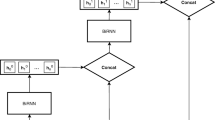Abstract
Electronic Medical Records (EMR) with unstructured sentences and various conceptual expressions provide rich information for medical information extraction. However, common Named Entity Recognition (NER) in Natural Language Processing (NLP) are not well suitable for clinical NER in EMR. This study aims at applying neural networks to clinical concept extractions. We integrate Bidirectional Long Short-Term Memory Networks (Bi-LSTM) with a Conditional Random Fields (CRF) layer to detect three types of clinical named entities. Word representations fed into the neural networks are concatenated by character-based word embeddings and Continuous Bag of Words (CBOW) embeddings trained both on domain and non-domain corpus. We test our NER system on i2b2/VA open datasets and compare the performance with six related works, achieving the best result of NER with F1 value 0.853 7. We also point out a few specific problems in clinical concept extractions which will give some hints to deeper studies.
Similar content being viewed by others
References
SAGER N, FRIEDMAN C, LYMAN M S. Review of medical language processing: computer management of narrative data [J]. Computational Linguistics, 1989, 15(3): 195–198.
UZUNER O, SOUTH B R, SHEN S, et al. 2010 i2b2/VA challenge on concepts, assertions, and relations in clinical text [J]. Journal of the American Medical Informatics Association. 2011, 18(5): 552–556.
CURRAN J R, CLARK S. Language independent NER using a maximum entropy tagger [C]//Proceedings of the 7th Conference on Natural Language Learning at HLT-NAACL. Edmonton, Canada: ACL, 2003: 164–167.
TJONG KIM SANG E F, DE MEULDER F. Introduction to the CoNLL-2003 shared task: Language-Independent named entity recognition [C]//Proceedings of the 7th Conference on Natural Language Learning at HLT-NAACL. Edmonton, Canada: ACL, 2003: 142–147.
COLLOBERT R, WESTON J, BOTTOU L, et al. Natural language processing (almost) from scratch [J]. Journal of Machine Learning Research, 2011, 12(8): 2493–2537.
HUANG Z, XU W, YU K. Bidirectional LSTM-CRF models for sequence tagging [EB/OL]. (2015-08-19). [2017-06-21]. https://arxiv.org/pdf/1508.01991v1.pdf.
LAMPLE G, BALLESTEROS M, SUBRAMANIAN S, et al. Neural architectures for named entity recognition [C]//Proceedings of NAACL-2016, San Diego, US: ACL, 2016: 260–270.
HOCHREITER S, SCHMIDHUBER J. Long shortterm memory [J]. Neural Computation, 1997, 9(8): 1735–1780.
LAFFERTY J, MCCALLUM A, PEREIRA F C N. Conditional random fields: Probabilistic models for segmenting and labeling sequence data [C]//Proceedings of the 18th International Conference on Machine Learning. Williamstown, US: IMLS, 2001: 282–289.
BOAG W, WACOME K, NAUMANN T, et al. CliNER: A lightweight tool for clinical named entity recognition [C]//AMIA Joint Summits on Clinical Research Informatics. San Francisco, CA: AMIA, 2015.
DE BRUIJN B, CHERRY C, KIRITCHENKO S, et al. Machine-Learned solutions for three stages of clinical information extraction: the state of the art at i2b2 2010 [J]. Journal of the American Medical Informatics Association, 2011, 18(5): 557–562.
WU Y H, XU J, JIANG M, et al. A study of neural word embeddings for named entity recognition in clinical text [C]//AMIA Annual Symposium Proceedings. 2015: 1326–1333.
JONNALAGADDA S, COHEN T, WU S, et al. Enhancing clinical concept extraction with distributional semantics [J]. Journal of Biomedical Informatics, 2012,45(1): 129–140.
CHALAPATHY R, BORZESHI, E Z, PICCARDI M. Bidirectional LSTM-CRF for clinical concept extraction [EB/OL]. (2016-10-19). [2017-06-21]. https://arxiv.org/pdf/1610.05858.pdf.
MIKOLOV T, CHEN K, CORRADO G, et al. Efficient estimation of word representations in vector space [EB/OL]. (2013-09-07). [2017-06-21]. https://arxiv.org/pdf/1301.3781v3.pdf.
BENGIO Y, SIMARD P, FRASCONI P. Learning long-term dependencies with gradient descent is difficult [J]. IEEE Transactions on Neural Networks, 1994, 5(2): 157–166.
GRAVES A, SCHMIDHUBER J. Framewise phoneme classification with bidirectional LSTM and other neural network architectures [J]. Neural Networks, 2005, 18(5/6): 602–610.
MIKOLOV T, SUTSKEVER I, CHEN K, et al. Distributed representations of words and phrases and their compositionality [EB/OL]. (2013-10-16). [2017-06-21]. https://arxiv.org/pdf/1310.4546.pdf.
FU X, ANANIADOU S. Improving the extraction of clinical concepts from clinical records [C]//Proceedings of the 4th Workshop on Building and Evaluating Resources for Health and Biomedical Text Processing. Reykjavik, Iceland: ELRA, 2014.
Author information
Authors and Affiliations
Corresponding author
Additional information
Foundation item: the National Social Science Foundation of China (No. 17BYY047)
Rights and permissions
About this article
Cite this article
Qin, Y., Zeng, Y. Research of Clinical Named Entity Recognition Based on Bi-LSTM-CRF. J. Shanghai Jiaotong Univ. (Sci.) 23, 392–397 (2018). https://doi.org/10.1007/s12204-018-1954-5
Received:
Published:
Issue Date:
DOI: https://doi.org/10.1007/s12204-018-1954-5
Key words
- clinical named entity recognition
- bidirectional long short-term memory networks
- conditional random fields




